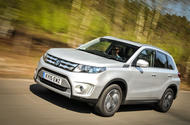
Vitara shreds its old-school roots to return as a lighter, lower SUV at the modest end of the class, but with driving ability beyond its price
This fascinating, ever changing, new car market of ours loves to confound and surprise. Its sands shift and class boundaries expand and contract all the time, somehow rarely leaving the car makers you expect to reap the benefit.Suzuki is a case in point: a maker with almost half a century of experience in making small 4x4s that’s only now getting around to taking a proper swing at the Skoda Yetis, Dacia Dusters and Vauxhall Mokkas of this world. Go figure. Suzuki’s entrant looks and sounds familiar but is different from any car wearing its nameplate before. Welcome, then, to the new Vitara.This new-groove compact SUV is related by platform to the Suzuki SX4 S-Cross crossover launched in 2013. The sister cars are quite cleverly differentiated, though. Whereas the SX4’s ruggedness is like that of a pair of Gore-Tex running shoes, the Vitara’s is more of a hiking boot.Upright, square-cornered and with plenty of air inside its wheelarches, the Vitara goes after the more high-rised, genuinely dual-purpose offerings among the new breed of supermini-based SUVs.That said, anyone trading into this car from its nearest recent antecedent in Suzuki’s range – the three-door, sub-4.0-metre Suzuki Grand Vitara – may be in for something of a shock.That predecessor was 1.7m tall and, with what Suzuki called a built-in ladder-frame chassis, approaching 1.5 tonnes in weight. It was an old-school 4×4 with a low-range transfer ’box and a 2.4-litre engine.This Vitara is lower, lighter and less powerful, the result of a modern, rebalanced approach to the kind of added-capability design currently surging up the European sales charts.Suzuki’s specific expertise in making small cars on the one hand and SUVs on the other stands to give it a decisive advantage with this car. Let’s find out if it actually has.Suzuki Vitara design & stylingContrary to what its more assertive SUV styling may suggest, the Vitara slots into Suzuki’s showroom range below the S-Cross – on price and on overall length.It’s reasonable to assume that a larger ‘Grand’ version will bookend that position at some point soon, taking the fight to the likes of the Mazda CX-5 and Ford Kuga. But even without back-up from a bigger brother, the normal Vitara could certainly hold its own among its burgeoning competitor set, being longer and taller than both a Renault Captur and the popular Nissan Juke.The Vitara’s stylistic references to the 1988 original come thick and fast when you run your eye from nose to tail. The obvious ones are the shape of the headlights and the rising feature lines on its flanks.Look harder and you’ll clock the clamshell bonnet and front wing vents as visual homage, too. What matters most is that Suzuki has penned a distinctive, sturdy, modern-looking design here – one with a more amiable and straightforward visual identity than plenty of its rivals.The Vitara model range is slightly truncated by Suzuki’s normal standards, featuring only SZ4, SZ-T, SZ5 and sporty S trim levels, our test car being an SZ5 model. But options to customise the car’s look are greater than Suzuki owners are used to.Several two-tone colour schemes are offered, with body and roof in contrasting paint, and you can also dress up your Vitara with special grille treatments and wheel arch garnishes, or with an Urban or Rugged accessory pack. The Urban pack gets you chrome foglight bezels and a roof spoiler, and the Rugged pack buys front and rear skidplates and extended bodyside mouldings.The body-in-white and suspension come adapted from service in the S-Cross. Ultra-high-strength steel in the body structure adds rigidity without extra weight. Revised lower arms, subframes and struts shore up the front axle and a U-shaped torsion beam suspension features at the rear.Engines, meanwhile, are limited to a 1.6-litre normally aspirated petrol or a DDiS turbodiesel, both peaking at 118bhp, and a turbocharged 1.4-litre Boosterjet engine producing 138bhp but is only available with the Vitara S. The petrol is the cheaper of the two when fitted with a five-speed manual gearbox and front-wheel drive as standard – and as tested – but it is also available with four-wheel drive and with a six-speed torque-converter automatic gearbox, either separately or together. The diesel is limited to a manual transmission, albeit with six speeds, but it comes in front-drive and all-paw formats. The Vitara S is the only petrol model to offer six-speed versions of the manual or automatic gearbox and only four-wheel drive form.Few rivals offer as much flexibility on engine, gearbox and drivetrain permutation. And even fewer do it while imposing such a negligible weight penalty as the Vitara. On our scales, the car weighed just 1124kg, against a claim of 1075kg and a class average that’s more like 1250kg. Impressive stuff.
Source: Autocar